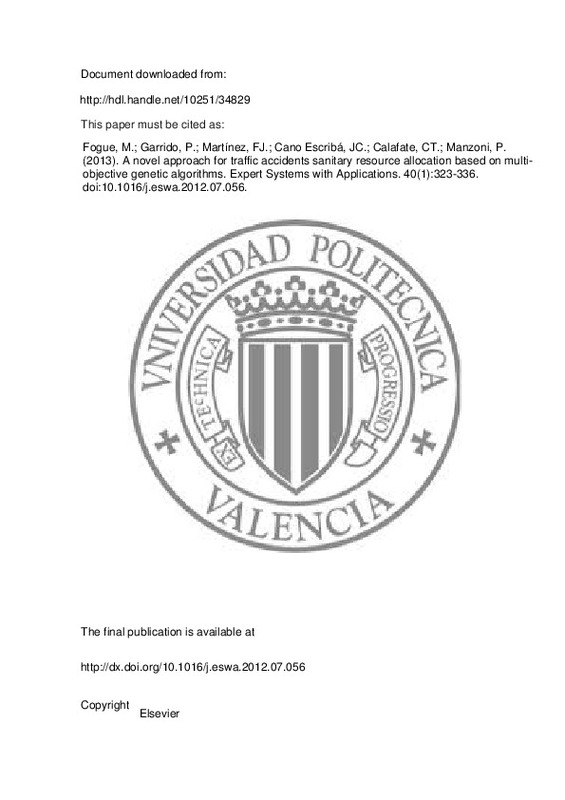JavaScript is disabled for your browser. Some features of this site may not work without it.
Buscar en RiuNet
Listar
Mi cuenta
Estadísticas
Ayuda RiuNet
Admin. UPV
A novel approach for traffic accidents sanitary resource allocation based on multi-objective genetic algorithms
Mostrar el registro sencillo del ítem
Ficheros en el ítem
| dc.contributor.author | Fogue, Manuel
|
es_ES |
| dc.contributor.author | Garrido, Piedad
|
es_ES |
| dc.contributor.author | Martínez, Francisco J.
|
es_ES |
| dc.contributor.author | Cano Escribá, Juan Carlos
|
es_ES |
| dc.contributor.author | Tavares de Araujo Cesariny Calafate, Carlos Miguel
|
es_ES |
| dc.contributor.author | Manzoni, Pietro
|
es_ES |
| dc.date.accessioned | 2014-01-09T10:18:20Z | |
| dc.date.issued | 2013-01 | |
| dc.identifier.issn | 0957-4174 | |
| dc.identifier.uri | http://hdl.handle.net/10251/34829 | |
| dc.description.abstract | [EN] The development of communication technologies integrated in vehicles allows creating new protocols and applications to improve assistance in traffic accidents. Combining this technology with intelligent systems will permit to automate most of the decisions needed to generate the appropriate sanitary resource sets, thereby reducing the time from the occurrence of the accident to the stabilization and hospitalization of the injured passengers. However, generating the optimal allocation of sanitary resources is not an easy task, since there are several objectives that are mutually exclusive, such as assistance improvement, cost reduction, and balanced resource usage. In this paper, we propose a novel approach for the sanitary resources allocation in traffic accidents. Our approach is based on the use of multiobjective genetic algorithms, and it is able to generate a list of optimal solutions accounting for the most representative factors. The inputs to our model are: (i) the accident notification, which is obtained through vehicular communication systems, and (ii) the severity estimation for the accident, achieved through data mining. We evaluate our approach under a set of vehicular scenarios, and the results show that a memetic version of the NSGA-II algorithm was the most effective method at locating the optimal resource set, while maintaining enough variability in the solutions to allow applying different resource allocation policies. 2012 Elsevier Ltd. All rights reserved. | es_ES |
| dc.description.sponsorship | This work was partially supported by the Ministerio de Ciencia e Innovacion, Spain, under Grant TIN2011-27543-C03-01, and by the Diputacion General de Aragon, under Grant "subvenciones destinadas a la formacion y contratacion de personal investigador". | en_EN |
| dc.format.extent | 14 | es_ES |
| dc.language | Inglés | es_ES |
| dc.publisher | Elsevier | es_ES |
| dc.relation.ispartof | Expert Systems with Applications | es_ES |
| dc.rights | Reserva de todos los derechos | es_ES |
| dc.subject | Resource allocation | es_ES |
| dc.subject | Traffic accidents assistance | es_ES |
| dc.subject | Multi-objective genetic algorithms | es_ES |
| dc.subject.classification | ARQUITECTURA Y TECNOLOGIA DE COMPUTADORES | es_ES |
| dc.title | A novel approach for traffic accidents sanitary resource allocation based on multi-objective genetic algorithms | es_ES |
| dc.type | Artículo | es_ES |
| dc.embargo.lift | 10000-01-01 | |
| dc.embargo.terms | forever | es_ES |
| dc.identifier.doi | 10.1016/j.eswa.2012.07.056 | |
| dc.relation.projectID | info:eu-repo/grantAgreement/MICINN//TIN2011-27543-C03-01/ES/WALKIE-TALKIE: SOPORTE A ENTORNOS DE TRANSPORTE SEGURO, INTELIGENTE Y SOSTENIBLE PARA LA FUTURA GENERACION DE COCHES INTELIGENTES/ | es_ES |
| dc.rights.accessRights | Abierto | es_ES |
| dc.contributor.affiliation | Universitat Politècnica de València. Departamento de Informática de Sistemas y Computadores - Departament d'Informàtica de Sistemes i Computadors | es_ES |
| dc.description.bibliographicCitation | Fogue, M.; Garrido, P.; Martínez, FJ.; Cano Escribá, JC.; Tavares De Araujo Cesariny Calafate, CM.; Manzoni, P. (2013). A novel approach for traffic accidents sanitary resource allocation based on multi-objective genetic algorithms. Expert Systems with Applications. 40(1):323-336. https://doi.org/10.1016/j.eswa.2012.07.056 | es_ES |
| dc.description.accrualMethod | S | es_ES |
| dc.relation.publisherversion | http://dx.doi.org/10.1016/j.eswa.2012.07.056 | es_ES |
| dc.description.upvformatpinicio | 323 | es_ES |
| dc.description.upvformatpfin | 336 | es_ES |
| dc.type.version | info:eu-repo/semantics/publishedVersion | es_ES |
| dc.description.volume | 40 | es_ES |
| dc.description.issue | 1 | es_ES |
| dc.relation.senia | 233495 | |
| dc.contributor.funder | Diputación General de Aragón | |
| dc.contributor.funder | Ministerio de Ciencia e Innovación |







![[Cerrado]](/themes/UPV/images/candado.png)

